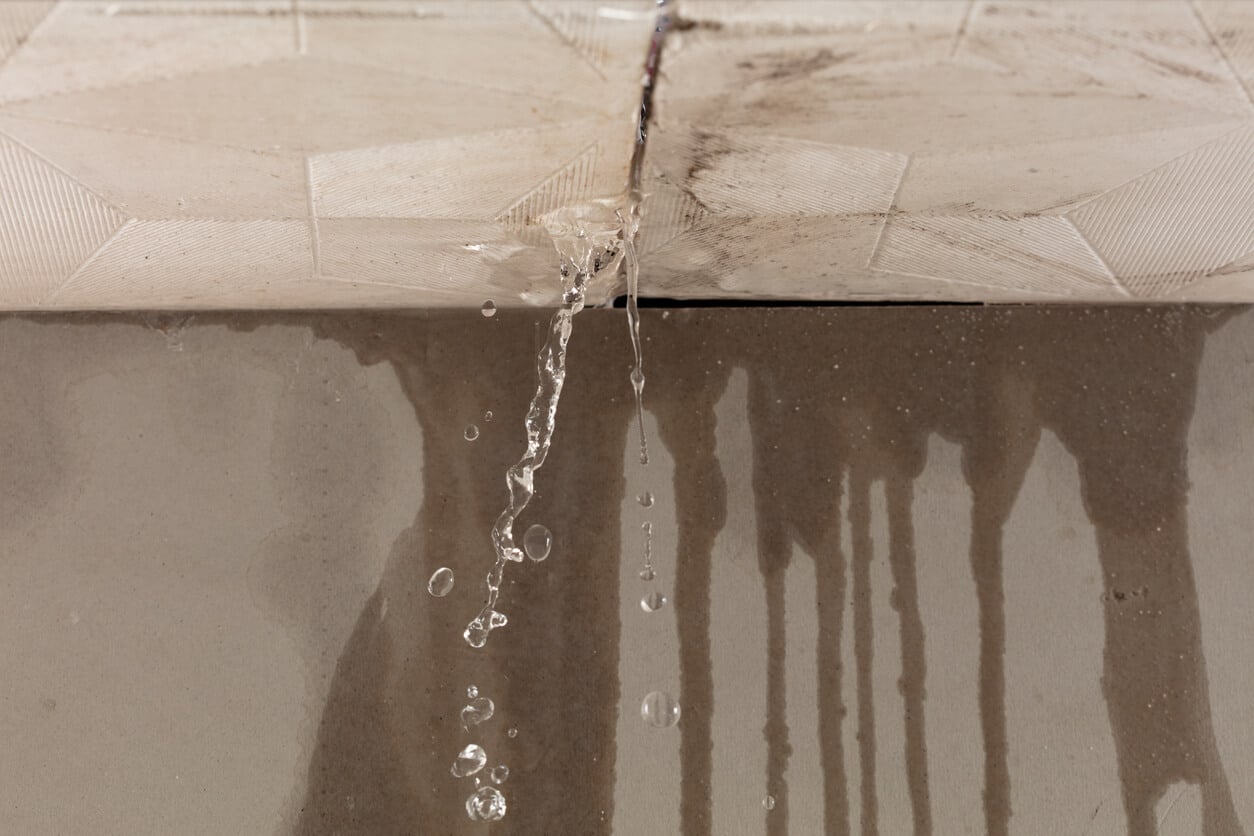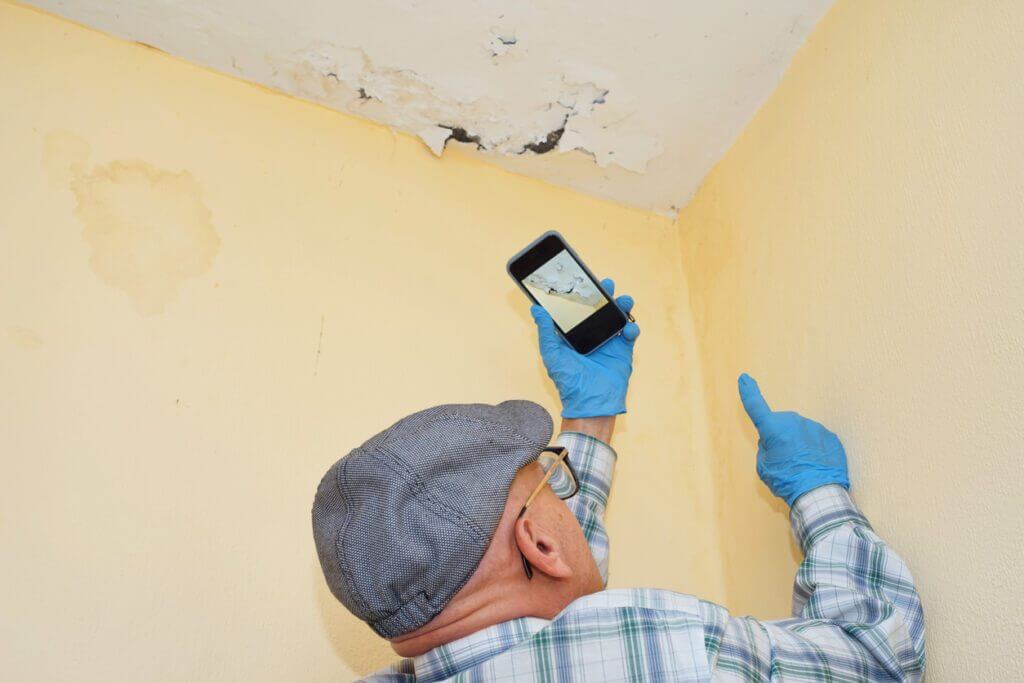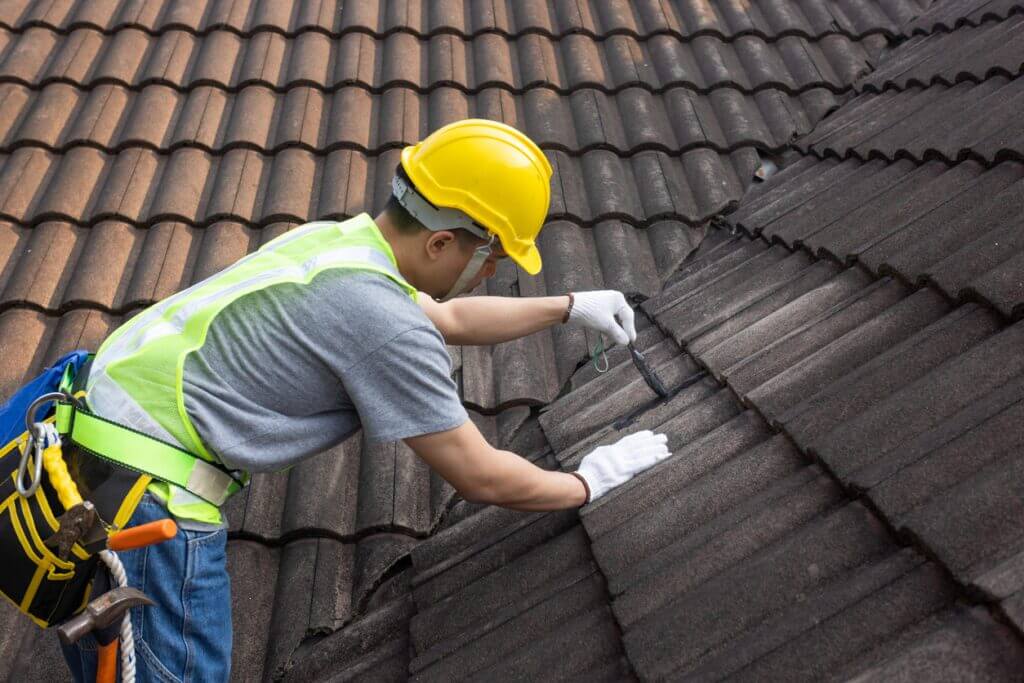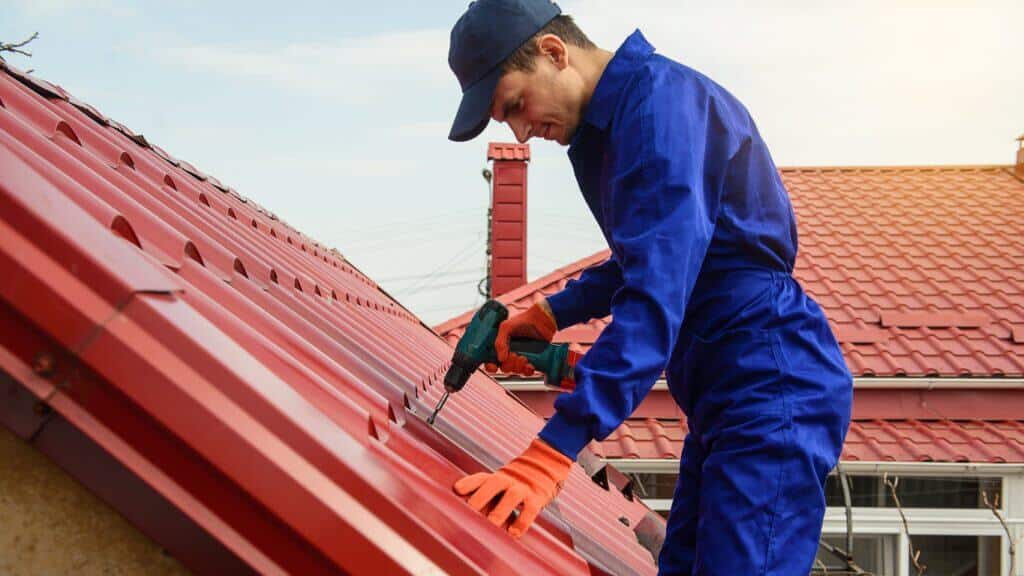
A discolored ceiling tile. That mysterious drip in the hallway. The faint scent of mildew wafting through the attic. It’s easy to dismiss these signs as minor annoyances until a full-blown roof leak demands your attention with water stains, damaged drywall, and a repair bill you weren’t expecting.
Roof leak repair isn’t just about fixing a hole; it’s about protecting your home’s structure, your belongings, and your sanity.
In Atlanta, where sudden downpours and humid summers are the norm, even the smallest roofing issue can escalate fast. Whether it’s a few missing shingles or a crack in the concrete roof, delaying repairs gives water more time to sneak in and wreak havoc.
But here’s the thing. Stopping water damage before it starts is entirely possible. You just need to know what to look for, when to act, and who to call. Let’s break down what you need to know to stay one step ahead of a leaking roof, and why quick, professional roof leak repairs are your best defense.
What Causes Roof Leaks?

Roof leaks don’t just appear out of nowhere. They’re usually the result of time, neglect, or a few too many storms hitting your home from just the wrong angle. If you’re trying to understand why water is suddenly invading your ceiling, these are the usual suspects behind residential roof leak repair:
1. Age and Wear (Especially on Older Homes)
Even the best roofs have an expiration date. Asphalt shingles, the most common roofing material in Atlanta homes, typically last around 20 to 30 years. Over time, exposure to heat, rain, and UV rays weakens roofing materials, making them brittle and prone to cracking. And once that protective layer starts to break down, it’s only a matter of time before a roof leak repair becomes necessary.
Older homes, especially those with original roofing, are prime candidates for roofing leak repair, not because the construction was bad, but because time waits for no roof.
2. Cracked or Missing Shingles
Missing or cracked shingles are one of the most visible signs of trouble. Without them, water has a direct path into your roofing system.
Keep an eye out for:
- Granule loss (those little sand-like particles in your gutters)
- Curled or lifted shingle edges
- Bare spots where shingles used to be
Each of these could lead to leaking roof repairs if not addressed quickly.
3. Pipe Boot Deterioration
A pipe boot is a fancy name for that rubber collar that seals the plumbing vent pipes coming out of your roof. Over time, that rubber dries out, cracks, and, surprise, leaks.
Pipe boot failures are one of the sneakier causes of roof repair leaks. They’re small, often overlooked during casual inspections, but they let in a surprising amount of water when compromised.
4. Flashing Failure (Around Chimneys, Walls, or Valleys)
Flashing is the thin metal installed where the roof meets vertical surfaces, such as walls, skylights, or chimneys. Its job? Redirect water so it doesn’t sneak into vulnerable joints. However, when flashing bends, rusts, or separates from the surface, it allows water to enter.
Flashing failures are a top reason homeowners call for roof leak repair, especially around chimneys, which are notorious trouble spots.
5. Improper Installation or Past Patch Jobs
Sometimes, the problem isn’t the weather or the age, it’s human error. A poorly installed roof or a lazy patch job from a previous leak can leave your home vulnerable.
Signs of poor workmanship include:
- Uneven shingle lines
- Exposed nails
- Sloppy sealant work
- Inconsistent flashing
If your home’s roof has had multiple quick-fix patches over the years, it might be time to think about a full roofing leak repair from a certified pro.
6. Concrete Roof Leak Repair and Low-Slope Roofing
Concrete roofs and low-slope designs are sleek, modern, and durable, but they have their quirks. Unlike pitched roofs that rely on gravity to shed water, low-slope roofs require perfect sealing to prevent pooling. And when cracks form in the concrete or seams begin to separate, water starts to seep in.
Concrete roof leak repair often involves:
- Sealing surface cracks
- Re-coating with waterproof membranes
- Improving drainage to prevent future pooling
These types of leaks can be tricky, especially since they often go unnoticed until significant water damage is already underway.
Whether it’s cracked shingles, failed flashing, or a worn-out pipe boot, the key to minimizing damage is catching problems early and calling in a roof leak repair expert before that small drip turns into a waterfall.
Signs Your Roof Is Leaking (Even If You Don’t See Water Yet)

Some of the most damaging leaks are the ones that creep in silently behind walls and under insulation. If you’re waiting for water to start dripping before scheduling a roof leak repair, you’re already behind.
Watch for these subtle signs that a roof repair leak might be in progress:
- Discoloration or bubbling on ceilings and walls
- Peeling paint near rooflines or window frames
- Musty odors, especially in attics or upstairs rooms
- Unexplained mold or mildew growth
- Warped or buckled drywall
These issues may seem minor at first glance, but they’re often the early symptoms of water intrusion. And once water gets into your attic or walls, it doesn’t just hang out—it invites rot, mold, and structural problems to the party.
Water Follows the Path of Least Resistance—Leak Source ≠ Drip Location
Here’s one of the trickiest things about roof leak repairs: where the water shows up isn’t always where the leak started. Water has a sneaky way of traveling along rafters, pipes, and insulation before finally dripping through a ceiling.
That stain in your living room? It could be from a compromised pipe boot two rooms over. A drip by the fireplace? Flashing failure up near the chimney might be to blame.
This is why professionals don’t just patch the drip—they trace the flow back to the actual entry point. Otherwise, you’re just playing whack-a-mole with water damage.
Why Inexperienced Roofers Often Miss Root Causes
Quick patches may stop a visible drip, but they often ignore the bigger issue. Inexperienced or rushed roofers might:
- Replace shingles without checking the underlayment
- Use generic sealants instead of system-specific materials
- Miss signs of rotted decking or failed flashing
- Skip over attic inspections entirely
That’s why it pays to hire someone who treats roof leak repairs as forensic work, not just a cosmetic fix. Surface-level repairs may hold for a few weeks, but if the root cause isn’t addressed, the leak will return. Often worse.
The Importance of Attic Moisture Checks, Decking Inspection, and Ventilation Review
A quality residential roof leak repair job goes beyond the shingles. A full inspection should always include:
- Attic Moisture Check: Hidden condensation or water stains can point to leak origins, even when the exterior looks fine.
- Decking Inspection: The plywood layer under your roofing materials may be soft, warped, or rotting, a red flag for deeper damage.
- Ventilation Review: Poor airflow traps moisture inside the attic, which can mimic leak symptoms or make existing leaks worse.
Skipping these steps can lead to repeat repairs and more costly fixes down the road. A good roofer will look under the surface, not just at it.
Emergency Roof Leak Repairs: What to Do Right Now

When water starts pouring in during a storm, there’s no time to debate or Google DIY hacks. You need fast action to protect your home and buy time until a pro can step in. Emergency roof leak repairs aren’t about perfection—they’re about damage control.
If Water Is Actively Leaking:
Start by staying calm, then take these steps to limit the chaos:
- Contain Water Inside: Use buckets, pots, or large plastic bins to collect dripping water. Lay down towels or tarps to protect floors and furniture.
- Cover the Area With a Tarp (If It’s Safe): If weather permits and you can do it without risking life or limb, covering the damaged section of roof with a tarp can slow the water’s entry.
- Document the Damage for Insurance: Take photos or videos of the leak, the affected areas, and any visible damage. Insurance claims go much smoother when you have visual proof.
These temporary measures won’t stop the leak, but they can prevent it from escalating into a full-blown disaster.
Call a Roof Leak Repair Expert for Same-Day Inspection
The moment the weather clears, get on the phone with a local roof leak repair expert. Many Atlanta roofing companies offer same-day emergency services, especially during peak storm seasons.
What to expect from a good roofing pro:
- Fast, safe access to your roof
- Moisture and damage assessment (interior and exterior)
- Temporary sealing or tarp application
- A plan for permanent leaking roof repairs
Delaying even a day can mean more moisture, more mold, and more money. The sooner you get a pro on-site, the faster you can restore your home, and your peace of mind.
Long-Term Roof Leak Solutions: Repair or Replace?

Not every roof leak is a crisis, some are a quick fix, others are a wake-up call that your roof’s best years are behind it. So how do you know if you need a simple roof leak repair or a full replacement?
Let’s elaborate below.
Comparison Table: Repair vs. Reroof by Cost and Scope
The answer to whether you need a repair or replacement lies in the scope, cost, and condition of your roof’s underlayers.
Factor | Roof Leak Repair | Full Roof Replacement |
Cost | $150-$1,500+ (depends on damage) | $5,000-$25,000+ (size/material dependent) |
Timeline | 1 day (typically) | |
Scope | Targeted fix (flashing, boot, shingles) | Full tear-off and replacement |
Lifespan Added | 1-5 years (depending on repair type) | 20-30 years (new roof system) |
When a Quick Fix (Like Flashing Reseal or Boot Replacement) Is Enough
If your roof is relatively new and the leak stems from something minor, say, cracked caulking around flashing or a worn pipe boot, you’re in luck. These targeted repairs are fast, cost-effective, and typically prevent the leak from recurring.
Common quick-fix scenarios:
- Flashing has pulled away from the chimney or siding
- Pipe boots have cracked but decking is still solid
- A few shingles blew off in a recent storm
- Skylight sealant is drying or lifting
In these cases, a professional roof leak repair can get you back to dry living without major expense or disruption.
When Decking or Structural Wood Rot Makes Replacement Necessary
Here’s when the conversation shifts from “repair” to “replace”:
- Spongy or sagging roof sections
- Visible wood rot or mold during attic inspection
- Repeat leaks in the same area
- Roofing system is 20+ years old
In these cases, the core issue isn’t the leak, it’s the weakened structure. A new roof isn’t just a cosmetic upgrade, it’s a necessary overhaul to protect your home long-term.
Common Leak-Prone Areas on Atlanta Homes
Atlanta’s weather, which includes seasonal storms, tree coverage, and intense humidity makes certain roof features more vulnerable to leaks than others. If you live in the area, these are the high-risk zones to watch, and maintain.
1. Pipe Boots
These rubber or metal flashings around vent pipes are among the most common sources of residential roof leak repair calls. Georgia heat can dry them out in just a few years, causing cracks that let water in around the pipe. A $15 part can cause thousands in water damage if left unchecked.
2. Chimney Flashing and Chimney Pans
Your chimney might look charming, but it’s a magnet for leaks. Flashing around chimneys often separates over time or rusts through, especially if not properly sealed. The chimney pan, a metal top that directs water away from the chimney base, can also corrode or loosen, leading to hidden leaks inside the attic or walls.
Tip: Have chimney flashing inspected every 2-3 years as part of routine roofing maintenance.
3. Skylights and Dormer Edges
Skylights bring in beautiful natural light, and sometimes, unexpected rainfall. Over time, the seals around skylights degrade, especially if they weren’t flashed correctly during installation. Dormers (those vertical roof extensions with windows) also collect water at their base, making them frequent culprits in roof leaks repair cases.
Common issues:
- Improper flashing or caulking
- Cracked skylight lens or frame
- Water pooling around dormer seams
4. Roof Valleys and Dead Walls
Where two roof slopes meet, you get a valley, and valleys are like express lanes for rainwater. If shingles are poorly installed or flashing is missing, that concentrated water flow can find its way in fast.
Dead walls, sections of vertical siding that meet a lower roof, are similarly vulnerable. Without proper step flashing and sealing, they become silent entry points for water.
5. Flat or Low-Slope Sections
Homes with modern or mixed-style architecture often include low-slope or flat roof sections. These areas require perfect drainage and water-tight materials. Unfortunately, Atlanta’s frequent rainstorms and leaf-heavy trees mean that debris buildup and ponding are common.
Concrete roof leak repair is especially important in these areas. Cracks in the surface or failed seams in the waterproof membrane are prime causes of slow, sneaky leaks that remain invisible until extensive damage has occurred.
Conclusion
Roof leaks rarely announce themselves with a loud bang. More often, they whisper, through subtle stains, faint odors, or a ceiling that suddenly sags under pressure. Whether you’re dealing with cracked shingles, deteriorating pipe boots, or a full-blown structural issue, addressing roof leaks early is the key to avoiding major water damage and costly repairs.
That’s why working with experienced, detail-oriented professionals matters.
Don’t leave your roof’s health up to chance. Contact us for a thorough inspection and same-day service when leaks strike. Whether it’s a flashing issue or a total roofing system overhaul, we’ll get the job done right, so you can get back to living dry, safe, and stress-free.
